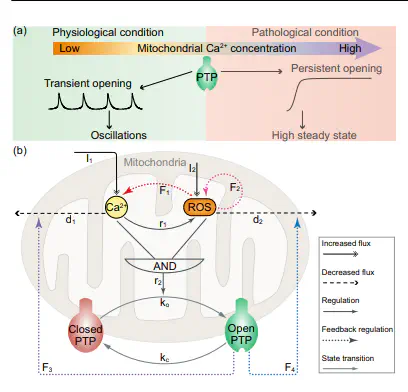Roles of four feedback loops in mitochondrial permeability transition pore opening induced by Ca^{2+} and reactive oxygen species

Abstract
Transient or sustained permeability transition pore (PTP) opening is important in normal physiology or cell death, respectively. These are closely linked to Ca^{2+} and reactive oxygen species (ROS). The entry of Ca^{2+} into mitochondria regulates ROS production, and both Ca^{2+} and ROS trigger PTP opening. In addition to this feedforward loop, there exist four feedback loops in the Ca^{2+}-ROS-PTP system. ROS promotes Ca^{2+} entering (F1) and induces further ROS generation (F2), forming two positive feedback loops. PTP opening results in the efflux of Ca^{2+} (F3) and ROS (F4) from the mitochondria, forming two negative feedback loops. Owing to these complexities, we construct a mathematical model to dissect the roles of these feedback loops in the dynamics of PTP opening. The qualitative agreement between simulation results and recent experimental observations supports our hypothesis that under physiological conditions the PTP opens in an oscillatory state, while under pathological conditions it opens in a high steady state. We clarify that the negative feedback loops are responsible for producing oscillations, wherein F3 plays a more prominent role than F4; whereas the positive feedback loops are beneficial for maintaining oscillation robustness, wherein F1 has a more dominant role than F2. Furthermore, we manifest that the proper increase in negative feedback strength or decrease in positive feedback strength not only facilitates the occurrence of oscillations and thus protects the system against a high steady state, but also assists in lowering the oscillation peak. This study may provide potential therapeutic strategies in treating neurodegenerative diseases due to PTP dysfunction.